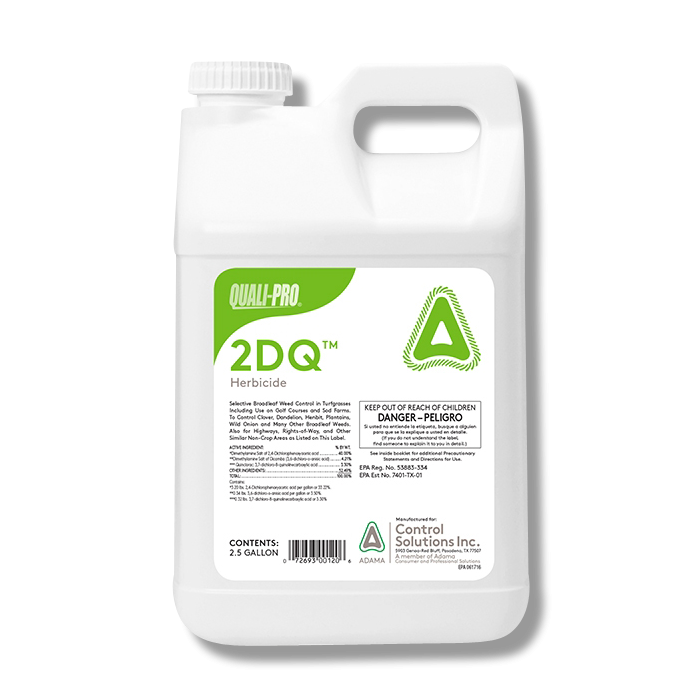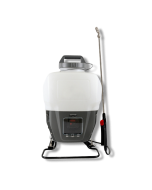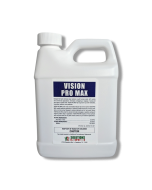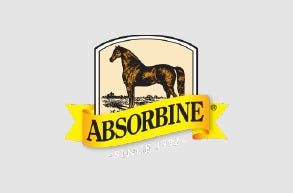2DQ Turf Herbicide Quinclorac
2DQ Turf Herbicide Quinclorac
2DQ Turf Herbicide Quinclorac, manufactured by Quali-Pro, is a powerful three-way post-emergent herbicide that controls 225 species of annual and perennial broadleaf weeds in warm-seasoned and cool-seasoned turf.
Formulated with 3 active ingredients 2,4-D 40.0%, dicamba 4.21%, and quinclorac 3.30% resulting in faster weed control at lower application rates, making it an economical herbicide. This easy to use suspended concentrate is absorbed by the unwanted foliage and roots then translocates throughout the plant to interfere with plant growth and cellulose production with symptoms showing in little as 5 days.
2DQ Turf Herbicide Quinclorac delivers impressive weed control without harming residential and other turfgrass sites. Easily can be mixed with other pre-emergent herbicides like Dithiopyr, Prodiamine, and many others making it a veratile post-emergent herbicide.
Tools Needed
To apply 2-DQ Turf Herbicide, you will need either a pump sprayer, a backpack sprayer or a skid sprayer.
How to Use
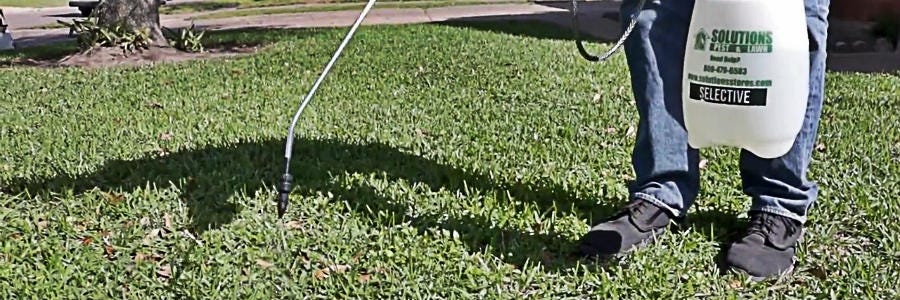
- Step 1: For optimum results, turf should not be mowed for 1 to 2 days before and after application of 2DQ Turf Herbicide Quinclorac. Determine how much 2DQ Turf Herbicide Quinclorac to use by measuring the square footage of the treatment area. To do this, measure the length and width of the treatment area in feet then multiply them together (length X width = square footage). For acreage, take the square footage and divide it by one acre (square footage / 43,560 sq. ft. = acre). Apply 0.75 to 1.1 fl. oz. of 2DQ Turf Herbicide Quinclorac per 1-5 gallons of water per 1,000 sq. ft. of cool-seasoned turfgrass. Use 0.37 to 0.9 fl. oz. of product per 1-5 gallons of water per 1,000 sq. ft. of warm-seasoned turfgrass. When using low-volume application equipment, apply 0.37 to 0.55 fl. oz. of product per 1 gallon of water per 1,000 sq. ft. of cool-season and listed warm-season grasses. The maximum single application rate is 3 pints of this product per acre. Make no more than two applications per year.
- Step 2: Fill your selected sprayer with half the amount of water, add measured amount of 2DQ Turf Herbicide Quinclorac, then pour remaining half of water into the spray tank.
- Step 3: Spray the top and bottom of weed leaves with 2DQ Turf Herbicide Quinclorac mixture until thoroughly wet, but not to the point of runoff. For control of woody plants, apply to both stems and foliage until all leaves, stems, and suckers are wet to the ground. For woody brush, wet all parts of the brush foliage, stem, and bark with product mixture. Avoid mist to vegetables, flowers, ornamentals, shrubs, trees, and other desirable plants. Do not pour spray solutions near these plants. Do water treated areas until 24 hours have passed after application and wait until 30 days have passed after last application before retreating with this product.
Where to Use
2DQ Turf Herbicide Quinclorac can be used on ornamental turf lawns (residential, industrial, and institutional), parks, cemeteries, athletic fields, golf courses (fairways, aprons, tees, and roughs), and similar turf areas. Also for use on sod farms.
Do not apply this product on or near vegetables, flowers, ornamentals, shrubs, trees, and other desirable plants. This product cannot be applied in or near greenhouses.
When to Use
Apply 2DQ Turf Herbicide Quinclorac when weeds are small and actively growing and when rainfall is not forecasted within 4 hours after application.
Reseed no sooner than 3 to 4 weeks after application of this product.
Avoid broadcast and small spot treatment applications when temperatures exceed 90 degrees Fahrenheit, as turf injury may occur.
Safety Information
2DQ Turf Herbicide Quinclorac is safe to use around children and pets when applied according to the product label instructions. Always wear the proper personal protective equipment (PPE) when mixing and applying this product.
Do not enter or allow people (or pets) to enter the treated area until sprays have dried.
Special Considerations
Exercise care when applying during growth stages from dormancy to green-up and from green-up to dormancy. Some temporary discoloration may occur on warm-season grasses.
| Availability | Online |
| Restricted Use | No |
| Shipping Restrictions | 2.5 Gallon: AK, AZ, CA, CT, HI, IN, MI, NY, OR, RI, SC, VT, WA |
| Brand | QUALI-PRO |
| Keith's Pro Tips | "2-DQ Turf Herbicide does a great job against weeds but applying it the right way is essential. Place a spray wand on a fan setting to get nice uniform coverage on target plants." |
| Product Drawbacks | Some temporary discoloration may occur on warm-season grasses with 2DQ Turf Herbicide Quinclorac. |
| Target Pests | Alder, Annual Yellow Sweet Clover, Artichoke, Austrian Fieldcress, Bedstraw, Beggartick, Biden, Bindweed, Bird Vetch, Bitter Wintercress, Bitterweed, Black Medic, Black Mustard, Black-eyed Susan, Black-Seed Pantain, Blessed Thistle, Blue Lettuce, Blue Vervain, Blur Ragweed, Boxelder, Bracted Plantain, Brassbuttons, Bristly Oxtongue, Broadleaf Dock, Broadleaf Plantain, Broomweed, Buckhorn, Buckhorn Plantain, Bulbous Buttercup, Bull Nettle, Bull Thistle, Burdock, Burning Nettle, Burweed, Buttercup, Canada Thistle, Carolina Geranium, Carpetweed, Catchweed Bedstraw, Catnip, Catsear, Chickweed, Chicory, Cinquefoil, Common Chickweed, Common Mullein, Common Sowthistle, Corn Chamomile, Creeping Jenny, Crimson Clover, Croton, Cudweed, Curly Dock, Curly Indigo, Daisy, Dandelion, Dead Bettie, Dock, Dogbane, Dogfennel, Dollar Weed, Elderberry, English Daisy, Fall Dandelion, False Dandelion, False Flax, False Sunflower, Fiddleneck, Field Bindweed, Field Pansy, Fleabane, Flixweed, Florida Betony, Florida Pusley, Frenchweed, Galinsoga, Garlic Mustard, Goathead, Goatsbeard, Goldenrod, Groundivy, Gumweed, Hairy Bittercress, Hairy Fleabane, Hawkweed, Heal All, Heartleaf Drymary, Hedge Bindweed, Hedge Mustard, Hemp, Henbit, Hoary Cress, Horsetail, Indiana Mallow, Ironweed, Jewelweed, Jimsonweed, Knawell, Knotweed, Kochia, Lambsquarter, Lespedeza, Locoweed, Lupine, Mallow, Marshelder, Matchweed, Mexicanweed, Mildweed Blood Flower, Milk Vetch, Morningglory, Mousear chickweed, Mugwort, Musk Thistle, Mustard, Narrowleaf Plantain, Narrowleaf Vetch, Nettle, Orange Hawkweed, Oxalis, Oxeye Daisy, Parsley Piert, Parsnip, Pearlwort, Pennycress, Pennywort, Peppergrass, Pepperweed, Pigweed, Pineywoods Bedstraw, Plains Coreopsis, Plantain, Poison Hemlock, Poison Ivy, Poison Oak, Poke Weed, Poorjoe, Povertyweed, Prostrate Spurge, Prostrate Vervain, Puncture Vine, Purslane, Ragweed, Red Sorrel, Redclover, Redroot Pigweed, Redstem Filaree, Rough Cinquefoil, Rough Fleabane, Roundleafed Marigold, Rush, Russian Pigweed, Russian Thistle, Scarlet Pimpernel, Scotch Thistle, Sheep Sorrel, Shepherdspurse, Slender Plantain, Smallflower Galinsoga, Smartweed, Smooth Dock, Smooth Pigweed, Sneezeweed, Southern Wild Rose, Sowthistle, Spanishneedle, Spatterdock, Speedwell, Spiny Amaranth, Spiny Cocklebur, Spotted Catsear, Spotted Knapweed, Spotted Spurge, Spurge, Spurweed, St.Johnswort, Stinging Nettle, Stinkweed, Stitchwort, Strawberry Clover, Sumac, Sunflower, Sweet Clover, Tall Nettle, Thistle, Tick Trefoil, Toad Flax, Trailing Crownvetch, Tumble Mustard, Tumble Pigweed, Velvetleaf, Venice Mallow, Veronica, Vetch, Virginia Buttonweed, Virginia Creeper, Virginia Pepperweed, Wavyleaf Bullthistle, Western Salsify, White Clover, White Mustard, Wild Aster, Wild Buckwheat, Wild Carrot, Wild Four-O'-Clock, Wild Garlic, Wild Geranium, Wild Lettuce, Wild Onion, Wild Parsnip, Wild Radish, Wild Rape, Wild Strawberry, Wild Sweet Potato, Wild Vetch, Wild Violet, Willow, Witchweed, Woodsorrel, Woolly Morningglory, Woolly Plantain, Wormseed, Yarrow, Yellow Rocket, and Yellowflower. |
| Application Equipment | Backpack Sprayer, Pump Sprayer, Spray Rig |
| Application Methods | Broadcast Spray, Spot Treatment |
| Active Ingredient | 2,4D 40%, Dicamba 4.21%, and Quinclorac 3.3%. |
| Product Type | Herbicide |
| Formulation | Emulsifiable Concentrate (EC) |
| Application Rate | Apply 0.75 to 1.1 fl. oz. of 2DQ Turf Herbicide Quinclorac per 1-5 gallons of water per 1,000 sq. ft. of cool-seasoned turfgrass. Use 0.37 to 0.9 fl. oz. of product per 1-5 gallons of water per 1,000 sq. ft. of warm-seasoned turfgrass. When using low-volume application equipment, apply 0.37 to 0.55 fl. oz. of product per 1 gallon of water per 1,000 sq. ft. of cool-season and listed warm-season grasses |
| Shelf Life | 2DQ Turf Herbicide Quinclorac will last up to 3 years when stored in a cool, dry area. Keep from freezing. |
| Yield | 2.5 gallons of 2DQ Turf Herbicide Quinclorac will cover up to 2 acres. |
| Use Sites | Outdoors |
| Time to Kill | 2DQ Turf Herbicide Quinclorac will kill weeds within 30 days of application. |
| Incompatible Grass Types | Fescue, Fine, Fescue, Tall, Kikuyugrass, St Augustine, Zoysiagrass |
| Incompatible Home Siding | Brick, Hardie Plank, Stone Veneer, Wood, Vinyl |
| EPA Registration # | 53883-334 |
| Restricted Use | No |
|---|---|
| Shipping Restrictions | AK, AZ, CA, CT, HI, IN, MI, NY, OR, RI, SC, VT, WA |
| Availability | Online |
| Signal Word | DANGER |
| Keith's Pro Tip | "2-DQ Turf Herbicide does a great job against weeds but applying it the right way is essential. Place a spray wand on a fan setting to get nice uniform coverage on target plants." |
| Target Pests Multi | Annual Yellow Sweetclover, Austrian Fieldcress, Bedstraw, Beggarticks, Biden, Bindweed, Bird Vetch, Bitter Winter Cress, Bitterweed, Black Medic, Black Mustard, Black-eyed Susan, Black-seed plantain, Blessed Thistle, Blue Lettuce, Blue Vervain, Bracted Plantain, Brassbuttons, Bristly Oxtongue, Broadleaf Dock, Broadleaf Plantain, Bulbous Buttercup, Bull Nettle, Bur Ragweed, Burweed, Buttercup, Canada Thistle, Carolina Geranium, Carpetweed, Catchweed Bedstraw, Catnip, Catsear, Chickweed, Cinquefoil, Common Chickweed, Common Mullein, Common Sowthistle, Creeping Jenny, Crimson Clover, Cudweed, Curly Dock, Curly Indigo, Dandelion, Dock, Dogbane, Dollarweed, English_Daisy, Fall Dandelion, False Flax, False Sunflower, Fiddleneck, Field Bindweed, Field_Pansy, Fleabane Daisy , Flixweed, Florida Betony, Florida Pusley, Frenchweed, Galinsoga, Garlic Mustard, Goathead, Goatsbeard, Gumweed, Hairy Bittercress, Hairy Fleabane, Hawkweed, Healall, Heartleaf Drymary, Hedge Bindweed, Hedge Mustard, Hemp, Henbit, Hoary Cress, Horsetail, Indiana Mallow, Ironweed, Jewelweed, Jimsonweed, Knawel, Knotweed, Kochia, Lambsquarters, Lespedeza, Locoweed, Lupine, Mallow, Marshelder, Mexicanweed, Milk Vetch, Milkweed Bloodflower, Morningglory, Mouseear Chickweed, Mugwort, Musk Thistle, Narrowleaf Plantain, Narrowleaf Vetch, Nettle, Orange Hawkweed, Oxalis, Oxeye Daisy, Parsley Piert, Parsnip, Pearlwort, Pennycress, Pennywort, Peppergrass, Pigweed, Pineywoods Bedstraw, Plains Coreopsis, Plantain, Poison Hemlock, Poison Ivy, Poison Oak, Pokeweed, Poorjoe, Poverty Weed, Prostrate Spurge, Prostrate Vevain, Puncture Vine, Purslane, Ragweed, Red Clover, Red Sorrel, Redroot Pigweed, Redstem Filaree, Rough Cinquefoil, Rough Fleabane, Roundleafed Marigold, Rush, Russian Pigweed, Russian Thistle, Scarlet Pimpernel, Scotch Thistle, Sheep Sorrel, Shepherdspurse, Slender Plantain, Smallflower Galinsoga, Smartweed, Smooth Dock, Smooth Pigweed, Sneezeweed, Southern Wild Rose, Sowthistle, Spanishneedles, Spatterdock, Speedwell, Spiny Amaranth, Spiny Cocklebur, Spotted Catsear, Spotted Knapweed, Spotted Spurge, Spurweed, St. Johnswort, Stinging Nettle, Stinkweed, Stitchwort, Strawberry Clover, Sunflower, Tall Nettle, Thistle, Tick Trefoil, Toadflax, Trailing Crown Vetch, Tumble Mustard, Tumble Pigweed, Velvetleaf, Venice Mallow, Veronica, Vervain, Virginia Buttonweed, Virginia Creeper, Virginia Pepperweed, Wavyleaf Bullthistle, Western Salsify, White Clover, White Mustard, Wild Aster, Wild Buckwheat, Wild Carrot, Wild Four-o’clock, Wild Garlic, Wild Geranium, Wild Lettuce, Wild Onion, Wild Parsnip, Wild Radish, Wild Rape, Wild Strawberry, Wild Sweet Potato, Wild Vetch, Willow, Witchweed, Woodsorrel, Woolly Morningglory, Woolly Plantain, Wormseed, Yarrow, Yellow Rocket, Yellowflower, Alder, Artichoke, Boxelder, Chicory, Croton, Elderberry, Goldenrod, Ground Ivy, Matchweed, Mustard, Sumac, Sweet Clover, Vetch, Wild Violet |
| Time to Kill | 2DQ Turf Herbicide Quinclorac will kill weeds within 30 days of application. |
| Chemical Type | Herbicide |
| Formulation | Emulsifiable Concentrate (EC) |
| Application Methods | Broadcast Spray, Spot Treatment |
| Product Drawbacks | Some temporary discoloration may occur on warm-season grasses with 2DQ Turf Herbicide Quinclorac. |
| Active Ingredient | 2,4D 40%, Dicamba 4.21%, and Quinclorac 3.3%. |
| Application Equipment | Backpack Sprayer, Pump Sprayer, Spray Rig |
| Mix Rate | Apply 0.75 to 1.1 fl. oz. of 2DQ Turf Herbicide Quinclorac per 1-5 gallons of water per 1,000 sq. ft. of cool-seasoned turfgrass. Use 0.37 to 0.9 fl. oz. of product per 1-5 gallons of water per 1,000 sq. ft. of warm-seasoned turfgrass. When using low-volume application equipment, apply 0.37 to 0.55 fl. oz. of product per 1 gallon of water per 1,000 sq. ft. of cool-season and listed warm-season grasses |
| Low Use Rate | 0.037 oz./1,000 sq. ft. |
| High Use Rate | 1.09 oz./1,000 sq. ft. |
| Use Sites | Outdoors |
| Yield | 2.5 gallons of 2DQ Turf Herbicide Quinclorac will cover up to 2 acres. |
| EPA Registration No. | 53883-334 |
| Shelf Life | 2DQ Turf Herbicide Quinclorac will last up to 3 years when stored in a cool, dry area. Keep from freezing. |
| Children or pets? | Yes |
| Property Characteristics | None |
-
Q:Can 2dq be sprayed at a reduced rate and be sprayed on 3 week old Bermuda seedlings? The main weed I am trying to prevent shading out new Bermuda is carpetweed. Thank you for your responses.6/20/21
-
Q:Is it ok to use as a post emergent on grain sorghum concept treated ?4/14/21
-
Q:Can I use this in my Tifway Bermuda Lawn in Texas?5/26/18A:If bermudagrass is dormant: Up to 3 pints per acre may be used. Some hybrid bermudagrasses may be sensitive to this product. Contact your local extension service weed control specialist
Camille Landry
5/29/18Certified Buyer -
Q:Will this kill poa annaual grass after it has emerged ?5/18/18A:Yes this product can if applied according to label directions. Learn more about poa annual control (also known as annual bluegrass) on this page. https://www.solutionsstores.com/annual-bluegrass-control
Asif B.
10/2/18Certified Buyer -
Q:how much water do you add to this spray?2/13/18A:The mix rates will vary from cool season to warm season grasses 0.5 ounces of the 2dq with 1 gallon of water for 1,000 sq ft would be a mix that can be applied to both the cool season and the warm season grass.
Tina Malone
2/14/18Certified Buyer
